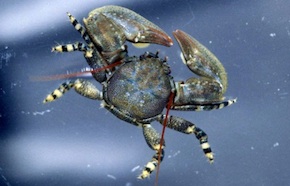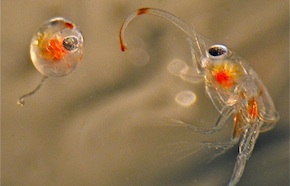New studies needed to predict how marine organisms may adapt to the future's acidic oceans
January 27, 2014 -- The world's oceans are becoming more acidic, changing in a way that hasn't happened for millions of years. But will marine organisms from tiny coccolithophores to king crabs change along with the waters?
SF State Associate Professor of Biology Jonathon Stillman has joined with an international team of scientists in calling for more studies of how these plants and animals might adapt to ocean acidification. Beyond a short-term adjustment to acidic waters, adaptation involves heritable changes in a species brought about by natural selection.

The porcelain crab, or Petrolisthes cinctipes. Photo by Jonathon Stillman.
Their article in the journal Trends in Ecology & Evolution offers "a way to move forward from people studying how organisms react to changes in the environment to being able to understand how they may evolve as the ocean changes," Stillman said.
If plants and animals adapt over time to acidification, they may respond to acidic waters in a much different way than they do in the current oceans, the scientists suggest.
"We really don’t need more studies that tell us how an organism is going to respond instantaneously," to acidification, he added. "We need to know how they will really respond in the future and that depends on their capacity for adaptation."
As the Earth's atmosphere becomes increasingly polluted by carbon dioxide emissions from the burning of fossil fuels, some of this carbon dioxide interacts with seawater to make it more acidic. Prominent studies within the past two years, including one linking the collapse of Pacific Northwest oyster hatcheries to acid waters, have turned acidification into a commercial and political issue as well as a scientific one.
Many labs are interested in knowing how organisms react to acidic, lower pH water conditions, including Stillman's at the Romberg Tiburon Center, which studies organisms such as coccolithophores and porcelain crabs. Researchers have uncovered a great deal of variety in these reactions, which can depend on the organism's life stages and where it lives within the ocean during those life stages.
But Stillman and colleagues say those kinds of studies showing how species react in the short term are not enough to predict what our oceans will look like in the future. Marine scientists need new tools --including genetic surveys and experimental evolution studies -- to discover how organisms might adapt in the long run to acidification.
Surveying the variety in genes related to how organisms respond to acidification could reveal the pathways through which adaptation might occur. Experimental evolution studies, where a group of organisms is bred under controlled acidic conditions, mimic the natural selection process that would occur in nature over tens or hundreds of years.

These porcelain crabs are at the beginning of their life cycle: a late-stage embryo (right) and a newly hatched larva (left). Photo by Jonathon Stillman.
The ideal experiment would be to follow "organisms over many generations, and to be able to look at what the genetic contribution is to how they respond to changes in their environment," Stillman said. "It would be similar to breeding studies that the biomedical community has been doing for a long time in animals like mice, but it's something that we don’t typically do that often or that well with marine organisms."
The hotspots for studying adaptation to acidity, Stillman said, are places where there is a strong variability in acidity already, such as the California coast. Upwelling of deeper, more acidic water along the coast has already produced a range of responses to acidity in creatures such as sea urchins, he noted.
These pulses of very acidic water along the California coast could increase as runoff pollutants, such as fertilizer nutrients, contribute to a rise in carbon dioxide that acidifies upwelled water. As temperatures rise inland as a result of global climate change, Stillman said, "We're going to see more of those intense winds that cause the upwelling of that acidified water."
All of these factors make it crucial for researchers to "retool" and pursue studies that get at the heart of long-term adaptation to acidification, Stillman said.
"We could go on forever just doing studies of our favorite organisms and whatever we can do in our lab in the short term," he noted, "but if we can't put it together in terms of being able to say something specific about their evolutionary capacity, then all we really know is how they'll respond if the ocean changed instantaneously to the ocean of 100 years from now."
###
SF State is the only master's-level public university serving the counties of San Francisco, San Mateo and Marin. The University enrolls nearly 30,000 students each year and offers nationally acclaimed programs in a range of fields -- from creative writing, cinema and biology to history, broadcast and electronic communication arts, theatre arts and ethnic studies. The University’s more than 219,000 graduates have contributed to the economic, cultural and civic fabric of San Francisco and beyond.